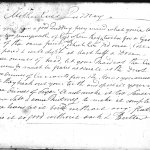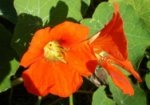Wondering what to do with the leftover turkey, ham and seafood? Try potting them!
(Potted prawns recipe below)
Potting perfection
One of our most successful education programs is titled ‘Pickled, potted and preserved’, designed for senior high school Food Technology students. Pickling and preserving in many forms are enjoying a renaissance, but what became of potting?
Potting is a method of preserving meats by protecting them from air, and therefore bacteria, in a similar way as the French used rendered pork fat (lard) or duck fat for confit or rillettes. Cold cooked meats, tongue, fowl and game birds (sometimes potted whole), hare, shellfish, anchovies or mushrooms would be chopped into pieces and pressed into a small earthenware pot; melted clarified butter was then poured in to fill any gaps. Appropriate herbs and spices such as allspice, nutmeg or mace, pepper and cayenne, would be added in the process.
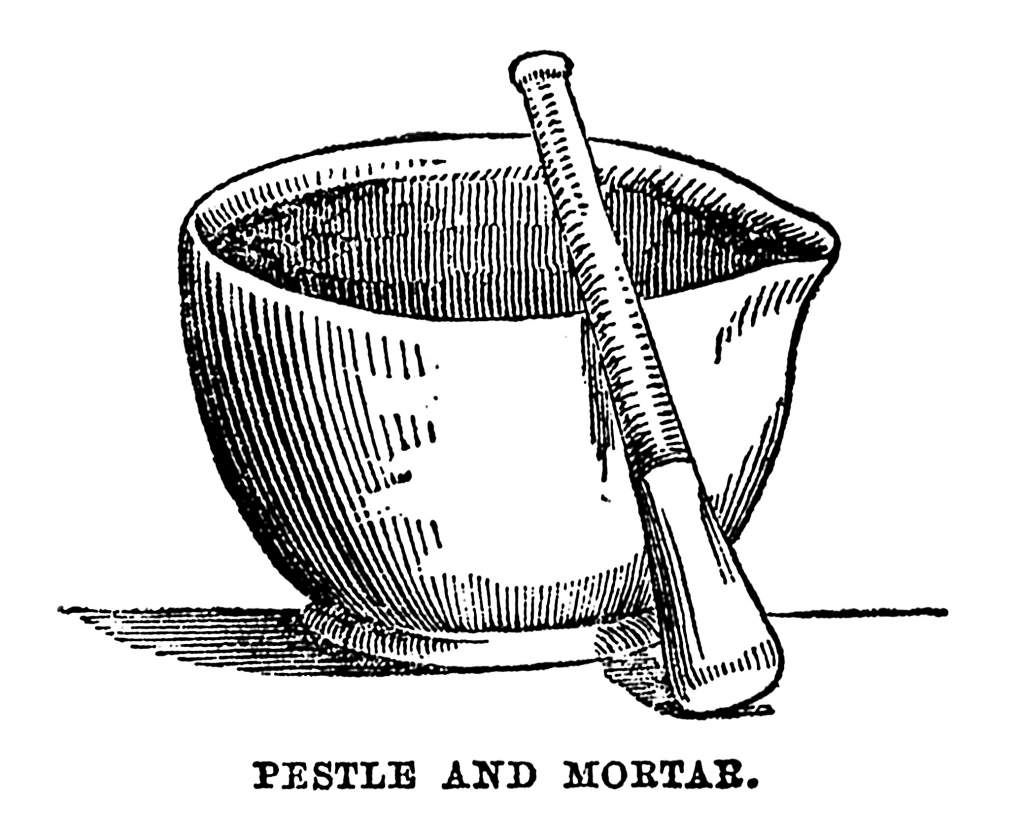
Pestle & Mortar. Image source Eliza Acton, Modern cookery for private families. 1855. (facsimile edition) © Southover Press, London, 1993
For a more refined, smoother texture, the fillings were pounded with fresh cold butter in a mortar with a pestle to make what my mother called a ‘poor man’s pâté’. This was quite an art, however. Eliza Acton instructs that the meat must be prepared carefully, cut by hand rather than through a mincer, and be “thoroughly reduced, to the smoothest possible paste… ” (see potted prawns recipe below). She cautioned however,
If rent into fragments, instead of being quite cut through the grain in being minced, before it is put into the mortar, no beating will bring it to the proper state. [1]
Cold meat cookery
While both potting processes produce a terrine or pate-like product, English food writer Elizabeth David points out that pates and terrines are cooked products, whereas potting used ready-to-eat ingredients [2]. Requiring no cooking, potting was economical in a land where butter was readily available, fuel efficient (albeit demanding a bit of physical labour for the maids in the kitchen) and a practical way of using leftover meats, transforming them into presentable and tasty dishes for the table. It is also why potting recipes are relegated to the inspiringly entitled ‘cold meat cookery’ section of 19th-century cookbooks. With the benefit of food processors we can cheat by blending to as smooth a paste as possible, but if you are hoping to satisfy Ms Acton’s exacting standards, the mixture will benefit from a few minutes pounding action with a pestle and mortar to make it ‘truly rent’ of fragments.
ELIZA ACTON’S POTTED HAM
Mince the meats with an exceedingly sharp knife, taking care to cut through the meat, and not tear the fibre, as on much of the excellence of the preparation depends. Next put into a large stone or marble mortar, and pound it to the smoothest paste with eight ounces fresh butter, which must be added by degrees. When three parts beaten, strew over it a teaspoonful of freshly-pounded mace, half a large, or the whole of a small nutmeg grated, and the third of a teaspoonful of cayenne well mixed together…keep the meat often turned from the sides to the middle of the mortar, that it may be seasoned equally in every part. When perfectly pounded, press it into small potting-pans, and pour clarified butter over the top.
If kept in a cool and dry place, this meat will remain good for a fortnight or more.
Lean of ham, 1lb (450g); lean of roast veal 6oz (170g) fresh butter, 8oz (225g) mace 1 – 2 tsp; 1/2 large nutmeg; cayenne 1/4 – 1/2 tsp.
A ‘ribband’ affect
Elizabeth Raffald offered a more dainty and attractive extension of the potting process in The Experienced English Housekeeper (1769), by preparing both ham and white chicken or turkey meat separately for potting, and press them into the pot in layers. For serving she suggests ‘when you send it to the table, cut out a thin slice in the form of half a diamond’ – I presume she means a triangle – ‘and lay it around the edge of your pot’.
Before shrimp hit the barbie, they were potted…
The popularity of potted foods in Australia is difficult to determine, conspicuous in their absence from many local texts. Edward Abbott’s English and Australian cookery book (1864) includes a very rich Potted Lobster, Mrs Maclurcan’s cookery book (1905) gives two versions of potted prawns – one using the pounding method, the other filling the gaps with melted clarified butter, and ‘Potted Meats’ using ‘juicy cold beef’ appears in The Golden Wattle cookery book (circa 1940s).
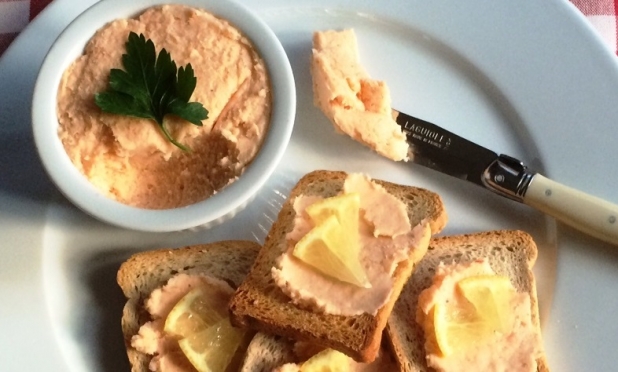
Potted prawns on toast. Photo © Jacqui Newling for Sydney Living Museums
From delicacy to much diminished legacy
Supermarket versions such as bottled anchovette and ham and chicken pastes are inferior descendants of these once-revered delicacies, as is the British classic patum peperium or Gentleman’s Relish, an anchovy paste. The only difference between anchovy butter or paste and potted anchovies according to her Book of Household Management (1861), is that the latter is made in the same way but with pounded mace, cayenne, and nutmeg added to taste.
It is interesting to note differences in preference and taste. For potted seafood and white meats in general Ms Acton advises,
Mace, nutmeg, and cayenne or white pepper, are the appropriate spices… A small quantity of cloves might be added to hare and other brown meat, but allspice we would not recommend unless the taste is known to be in favour of it.
Mrs Beeton, an ardent allspice fan, did not concur, including allspice in her potted ham and hare recipes.
Morning, noon or night?
Like many other dishes that once graced finer tables, the place of potted foods shifted over time. They were generally served with crisped toast as part of a meal: in the late 18th and early 19th-centuries as ‘entrements’ or side dishes on a formal table, or as a supper dish. As the 19th-century progressed and the dinner hour moved into the evenings they became fashionable breakfast or luncheon dishes. Writing in the 1960s, culinary doyenne Elizabeth David identified potted meats as “fundamentally and uniquely English… store-cupboard provisions” traditionally served at breakfast [2]. Demanding “first-class ingredients and a liberal hand with butter” she regarded them “a delicious first course for lunch … eaten very cold, with hot thin toast” [3,4].
Potted prawns
Ingredients
- 750g fresh cooked whole prawns or 400g prawn meat
- 100g good quality butter
- 1/2 teaspoon mace or nutmeg, ground (or to taste)
- 1/4 teaspoon cayenne pepper or sweet paprika (or to taste)
- 1/4 teaspoon white pepper, ground (or to taste)
- salt (to taste)
- 2 teaspoons lemon juice (optional)
Note
This recipe is based on Eliza Acton's 'Potted shrimps, or prawns', subtitled 'Delicious' (1855).
You can save quite a bit of time and energy by using a food processor, but at the expense of the properly melded texture achieved by pounding in a mortar. Cheat perhaps, giving yourself a head start with a quick pulse to start things along, and then proceed the traditional way, using mortar and pestle.
Directions
| Peel and devein the prawns, then chop them finely. Pound them in a mortar and pestle with the spices and a quarter of the butter until smooth, adding more butter a tablespoon or so at a time, and lemon juice, if using. Taste and adjust seasoning. Transfer the mixture to a small 'pot' or ramekin and garnish with a parsley leaf or sprinkle of cayenne or paprika. Serve on crisp toast. | |
| Cook's tip: the lemon juice helps cut the richness. | |
Sources and further reading:
[21Eliza Acton, Modern cookery for private families (1855) Southover Press, UK. 2002 Reprint of the extended edition of 1855.
[2] Elizabeth David, An omelette and a glass of wine. (1955-1984) 1984. p. 217, 221
[34Elizabeth David, Salt, spices and aromatics in the English kitchen (1950). 2000. p. 99
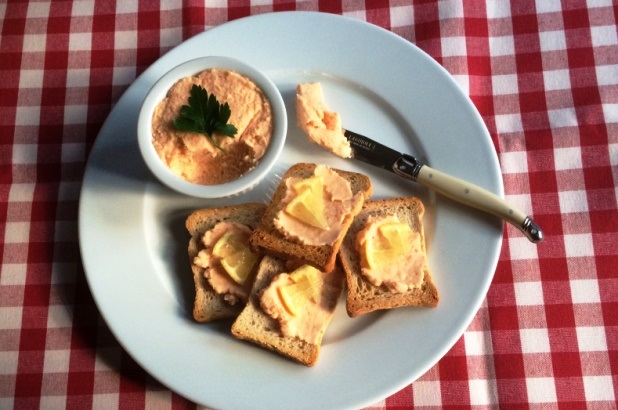
 Print recipe
Print recipe
